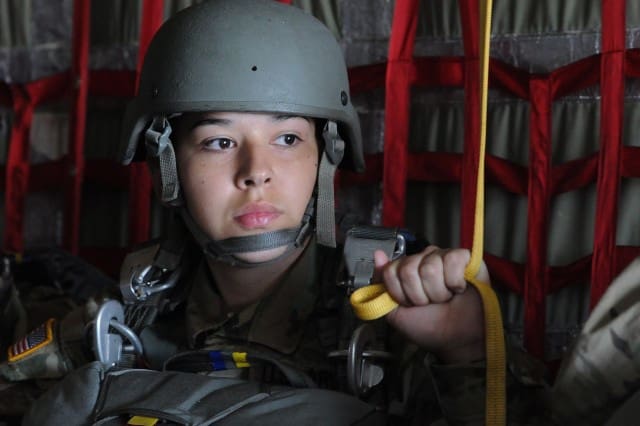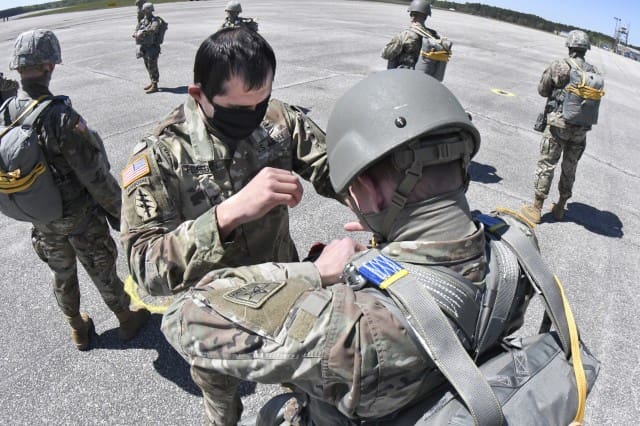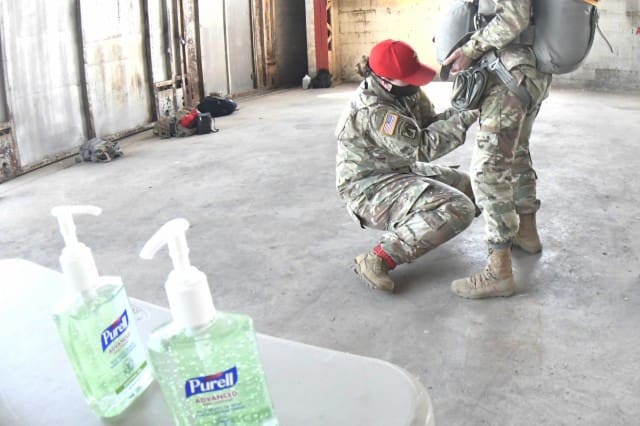
FORT PICKETT, Va. – The sky above this installation was once again filled with paratroopers dropping from aircraft as the Quartermaster School resumed airborne operations April 22.
The Virginia National Guard base – a 45-minute drive west of Fort Lee – is where the QMS Aerial Delivery and Field Services Department conducts airborne operations for parachute riggers.

Staff Sgt. Raymond Debusshere, an instructor, said his department last conducted jump training March 12. It has since undergone a thorough review and reassessment to determine how to best conduct such operations without putting paratroopers at risk for contracting COVID-19.

“We’ve added various safety precautions,” said the jumpmaster from a hangar skirting Pickett’s massive airfield. “We are practicing spacing, and every jumper out here has a face mask. In addition, we’re using hand sanitizer before and after every JMPI. We also added lifts (flights) to maintain spacing on the aircraft.”

JMPI, or Jumpmaster Personnel Inspections, is a safety process ensuring every paratrooper is prepared for the operation prior to boarding the aircraft. Jumpmasters meticulously check straps and equipment placement to ensure they’re secure and not likely to cause injury. With all the precautions taken, the operation took longer than usual, Debusshere admitted. “(It) added a lot to the process, but it was crucial and it worked out well.”
The QM School is one of the few Army entities outside of operational units that has resumed airborne operations. Not surprisingly, the task of securing aircraft through normal channels for the mission proved to be a challenge because the coronavirus pandemic has shifted air support functions across the Department of Defense.
“It was an undertaking calling different units and trying to get them to come in,” said ADFSD’s Kenneth Pygatt, airborne operations coordinator. “Some units have been willing, but their commands (are being highly selective in the approval of flights). It has been a task to bring it all together, but we got it done.”

There are no aircraft assets assigned to Fort Lee, thus, airborne operations must be coordinated through aviation units spanning the entire region. Active duty Marine aviators from Cherry Point, N.C., supported the April 22 drop. There are roughly 20 different aviation units that support the rigger course, Pygatt said.
Despite all that has taken place to resume training, parachute rigger students seemed oblivious to the changes. Many of them were in the first few weeks of the 92-Romeo course when the pandemic-necessitated measures such as social distancing became the “new normal.” It was apparent at the airfield they had become accustomed to it. They were focused on the day’s mission – jumping a parachute they packed themselves to demonstrate confidence in their abilities. It has always been a course graduation requirement. All of that seemed to overshadow even the pandemic precautions.
“I’m just excited to jump,” said a masked Pvt. Angelica Gonzalez while waiting for her lift. “It has been a while since I’ve been up there (all students complete the Basic Airborne Course at Fort Benning, Ga., before coming to Fort Lee), so it’s a refreshing moment for me.”

The Charlie Company, 262nd QM Battalion Soldier was one of 28 rigger students making their culmination jump. Numerous NCOs and officers also participated to keep their airborne-qualification status current.
More than 600 Parachute Rigger Course students graduate from ADFSD annually. The Fort Lee training is 14 weeks long.
By Terrance Bell


That jump after packing your chute for a grade was almost more nerve wracking than my first actual jump
Generally speaking your test jump is your first not Airborne school jump, so you REALLY a cherry with a massive responsibility on your shoulders to not kill or injure yourself